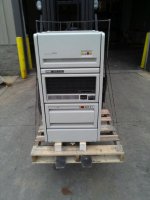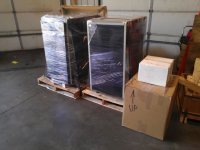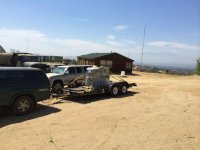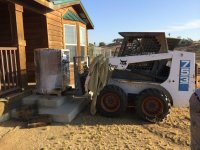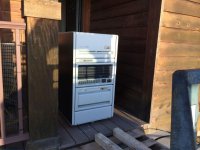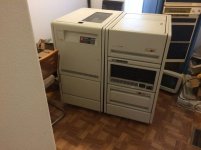A minor update: I've gotten to the point where I finally applied power to the main cabinet. The R80 spins up and indicates readiness without making any terrifying sounds, as does the RL02. I can get the console up to the "ROM>" prompt, but it can't read any of the console tapes that I have (yes, I already cleaned the drives and replaced the rubber on the capstans). I've downloaded some supposed 11/130 console tape images, so I guess that my next step will be to splice in my laptop in place of the TU58 drive and try to bring up the console with tu58em.
I've also bought a really nice looking LA120 DECwriter III on eBay to use as a printing console terminal, and hope to get it in another week or so. Naturally, it's traveling all the way across the continent by truck freight. Sigh!
I've been thinking about making a TU58 emulator in the same form factor as a TU58 tape cartridge, such that it can snap into an existing TU58 drive with its cables snaking into the bowels of the machine to connect in place of the original drive. Or maybe inline between the CPU and original drive, so one unit of a dual-drive TU58 can remain available while the other is emulated? It would accept two SD cards to emulate the two units of a TU58 drive.
Who knows if I'll even find the gumption and attention span to complete the project, but this 11/730 should help encourage me. Emulating a console tape drive on something like an 11/750 or 11/730 was one of my motivations to come up with this idea.
One way that I plan to diverge from other solutions that I've seen is in the user interface: Rather than having an LCD and buttons to select images from SD cards (and thus having a bigger and more obtrusive mechanical footprint), I'll just treat each SD card as a single TU58 cartridge and map the raw image to the first 256k (or up to 32M if desired for oversized images) of the SD card. Yes, most of the card's capacity would be wasted. But SD cards are dirt cheap. Cheaper than blank TU58 tapes were back in the day, if I'm not mistaken. And this would result in the same user interface as the original TU58 drive: Pick out the desired piece of plastic from a box, shove it into the hole, and hope it works.

In the case of the 11/730, an emulator like I envision could be installed in the internal drive where it's out of sight, leaving the front drive still available for dealing with real tapes. Or it could pop into the front drive for easier access without looking too ugly. In my PDP-11V03-L, I figure I'd velcro it inside of the RX02 drive. It would be out of sight, but easily accessible by sliding the RX02 drive out a couple inches on its slide rails. There's a lot of empty space inside that drive, given how small we can easily make electronic doodads these days.


